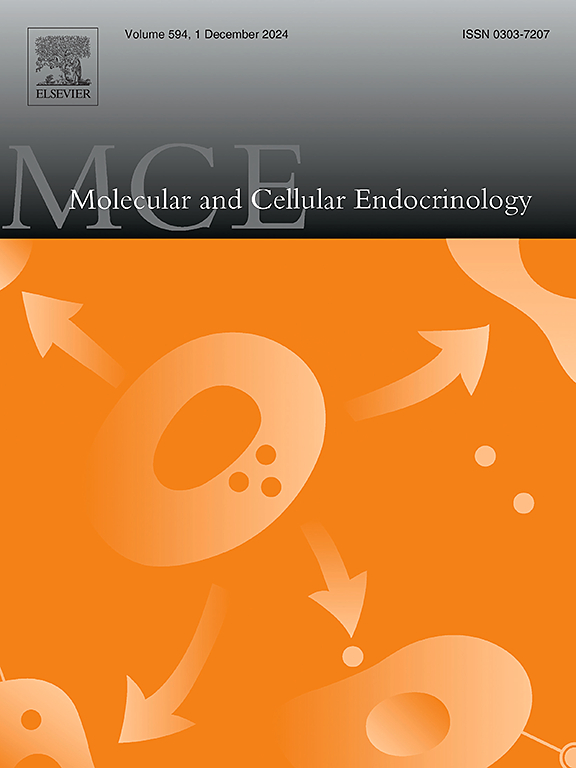5,7,3 ',4 ',5 ' -五甲基甲黄酮(PMF)在肥胖斑马鱼模型中具有抗肥胖和神经保护作用
IF 3.6
3区 医学
Q2 CELL BIOLOGY
引用次数: 0
摘要
肥胖症是一种多发性慢性疾病,其特点是多余脂肪堆积,导致严重的代谢和神经并发症。目前的治疗方法疗效有限,副作用显著,因此迫切需要更安全的新型替代药物。本研究首次利用斑马鱼模型在体内研究了5,7,3′,4′,5′-五甲氧基黄酮(PMF)的抗肥胖潜力。我们的研究结果表明,给斑马鱼服用五甲氧基黄酮具有明显的抗肥胖作用,血糖、血浆甘油三酯、总胆固醇、肝脏低密度脂蛋白(LDL)和高密度脂蛋白(HDL)均有所降低。从机理上讲,PMF 通过激活过氧化物酶体增殖激活受体-α(PPAR-α)及其下游酶,包括酰基-CoA 氧化酶 1(ACOX1)、中链酰基-CoA 脱氢酶(ACADM)和肉碱棕榈酰基转移酶 1B(CPT-1β),抑制肝脏脂肪生成和脂肪生成基因的表达,同时促进脂质分解。此外,PMF 通过降低丙二醛(MDA)和一氧化氮(NO)水平,显著减轻了氧化应激,同时提高了超氧化物歧化酶(SOD)、过氧化氢酶(CAT)、谷胱甘肽过氧化物酶(GSH-Px)和谷胱甘肽 S-转移酶(GST)等抗氧化酶的活性。值得注意的是,PMF 通过抑制食物摄入、下调厌食基因和增强厌食信号来有效预防肥胖。此外,PMF 通过提高脑源性神经营养因子(BDNF)及其受体肌球蛋白受体激酶 B2(TrkB2),显示出神经保护特性,揭示了代谢与神经调节之间的新联系。这项研究提供了开创性的、全面的体内证据,支持 PMF 成为有希望的候选疗法,在代谢健康和神经保护方面发挥双重有益作用。本文章由计算机程序翻译,如有差异,请以英文原文为准。

5,7,3′,4′,5′-pentamethoxyflavone (PMF) exhibits anti-obesity and neuroprotective effects in an obese zebrafish model
Obesity is a multi-chronic illness characterized by superfluous fat accumulation, contributing to significant metabolic and neurological complications. Current therapeutic approaches have limited efficacy and notable side effects, underscoring an urgent demand for novel, safer alternatives. This study is the first to investigate the anti-obesity potential of 5,7,3′,4′,5′-pentamethoxyflavone (PMF) in vivo using a zebrafish model. Our findings demonstrate that PMF administration exerts pronounced anti-obesogenic effects, evidenced by reductions in blood glucose, plasma triglycerides, total cholesterol, hepatic low-density lipoproteins (LDL), and high-density lipoproteins (HDL). Mechanistically, PMF suppressed hepatic adipogenic and lipogenic gene expression while promoting lipid catabolism through activation of peroxisome proliferator-activated receptor-alpha (PPAR-α) and its downstream enzymes, including acyl-CoA oxidase 1 (ACOX1), medium-chain acyl-CoA dehydrogenase (ACADM), and carnitine palmitoyl transferase 1B (CPT-1β). Additionally, PMF markedly mitigated oxidative stress by lowering malondialdehyde (MDA) and nitric oxide (NO) levels, accompanied by increased antioxidant enzyme activities, including superoxide dismutase (SOD), catalase (CAT), glutathione peroxidase (GSH-Px), and glutathione S-transferase (GST). Notably, PMF effectively prevented obesity by suppressing food intake, downregulating orexigenic genes, and enhancing anorexigenic signals. Furthermore, PMF exhibited neuroprotective properties by elevating brain-derived neurotrophic factor (BDNF) and its receptor tropomyosin receptor kinase B2 (TrkB2), revealing a novel link between metabolic and neurological regulation. This study provides pioneering, comprehensive in vivo evidence supporting PMF as a promising therapeutic candidate with dual beneficial roles in metabolic health and neuroprotection.
求助全文
通过发布文献求助,成功后即可免费获取论文全文。
去求助
来源期刊

Molecular and Cellular Endocrinology
医学-内分泌学与代谢
CiteScore
9.00
自引率
2.40%
发文量
174
审稿时长
42 days
期刊介绍:
Molecular and Cellular Endocrinology was established in 1974 to meet the demand for integrated publication on all aspects related to the genetic and biochemical effects, synthesis and secretions of extracellular signals (hormones, neurotransmitters, etc.) and to the understanding of cellular regulatory mechanisms involved in hormonal control.
 求助内容:
求助内容: 应助结果提醒方式:
应助结果提醒方式:


